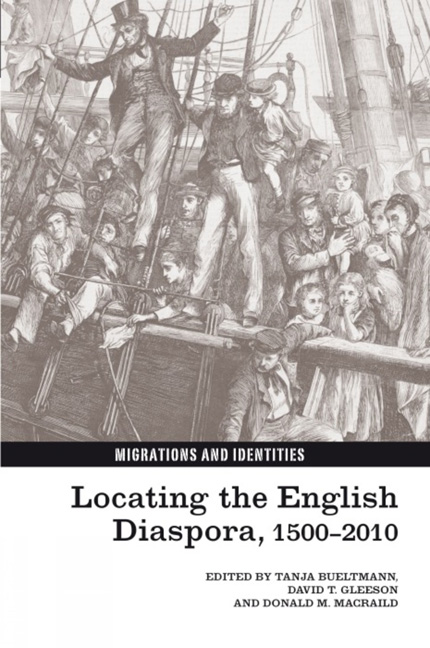Book contents
- Frontmatter
- Contents
- Notes on Contributors
- Introduction. Locating the English Diaspora: Problems, Perspectives and Approaches
- 1 Mythologies of Empire and the Earliest English Diasporas
- 2 The English Seventeenth Century in Colonial America: The Cultural Diaspora of English Republican Ideas
- 3 Fox Hunting and Anglicization in Eighteenth-Century Philadelphia
- 4 The Hidden English Diaspora in Nineteenth-Century America
- 5 An English Institution? The Colonial Church of England in the First Half of the Nineteenth Century
- 6 The Importance of Being English: English Ethnic Culture in Montreal, c.1800–1864
- 7 Anglo-Saxonism and the Racialization of the English Diaspora
- 8 ‘The Englishmen here are much disliked’: Hostility towards English Immigrants in Early Twentieth-Century Toronto
- 9 Cousin Jacks, New Chums and Ten Pound Poms: Locating New Zealand's English Diaspora
- 10 ‘Cooked in true Yorkshire fashion’: Regional Identity and English Associational Life in New Zealand before the First World War
- 11 Englishness and Cricket in South Africa during the Boer War
- 12 An Englishman in New York? Celebrating Shakespeare in America, 1916
- 13 The Disappearance of the English: Why is there no ‘English Diaspora’?
- Index
11 - Englishness and Cricket in South Africa during the Boer War
- Frontmatter
- Contents
- Notes on Contributors
- Introduction. Locating the English Diaspora: Problems, Perspectives and Approaches
- 1 Mythologies of Empire and the Earliest English Diasporas
- 2 The English Seventeenth Century in Colonial America: The Cultural Diaspora of English Republican Ideas
- 3 Fox Hunting and Anglicization in Eighteenth-Century Philadelphia
- 4 The Hidden English Diaspora in Nineteenth-Century America
- 5 An English Institution? The Colonial Church of England in the First Half of the Nineteenth Century
- 6 The Importance of Being English: English Ethnic Culture in Montreal, c.1800–1864
- 7 Anglo-Saxonism and the Racialization of the English Diaspora
- 8 ‘The Englishmen here are much disliked’: Hostility towards English Immigrants in Early Twentieth-Century Toronto
- 9 Cousin Jacks, New Chums and Ten Pound Poms: Locating New Zealand's English Diaspora
- 10 ‘Cooked in true Yorkshire fashion’: Regional Identity and English Associational Life in New Zealand before the First World War
- 11 Englishness and Cricket in South Africa during the Boer War
- 12 An Englishman in New York? Celebrating Shakespeare in America, 1916
- 13 The Disappearance of the English: Why is there no ‘English Diaspora’?
- Index
Summary
The mid-to-late nineteenth century witnessed a tremendous growth in cricket's significance across the globe. Within Britain and the colonies, the game came to symbolize the very essence of English Victorian society and the promotion of white Anglo-Saxon values. ‘It is difficult to underestimate the importance of cricket in Victorian life’, explains Keith Sandiford. The game ‘was a ritual as well as recreation, a spiritual as well as a sporting experience. Its values were used freely by politicians, philosophers, preachers and poets.’ It became the ‘imperial game’ and, above all else, it was an English creation.
Cricket spread to all societies across the Anglo-world where organized games were played: India, the Caribbean and Australia. Here it had been transformed from a simple, pastoral game into a powerful and symbolic force representing all that was deemed by the ruling classes to be worthy in the Anglo-Saxon character. ‘In a fiercely nationalistic era Englishmen regarded cricket, an exclusively English creation unsullied by outside influence, as proof of their cultural supremacy.’ It was a time of complacency, security and opulent pride. Victoria had expanded her empire to South Africa and here too cricket came to symbolize ‘Englishness’ and the civilizing mission of the Englishman abroad.
Cricket's attraction to the English Diaspora, being the conscious community of expatriate English around the world, came in its exclusiveness, its codes of practice and an ethos that made it distinctly ‘English’. Cricket was a product of England. Its customs and traditions had been shaped in the
- Type
- Chapter
- Information
- Locating the English Diaspora, 1500–2010 , pp. 185 - 204Publisher: Liverpool University PressPrint publication year: 2012



